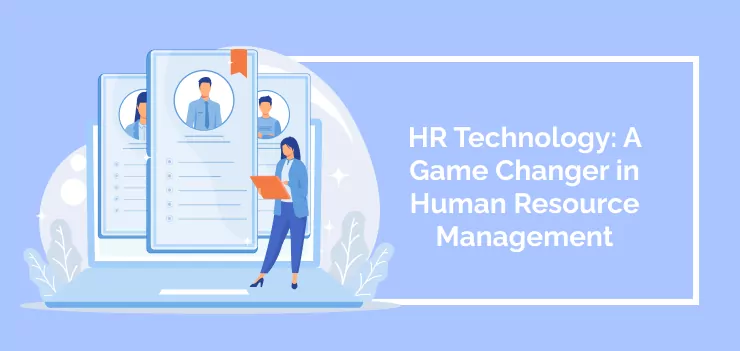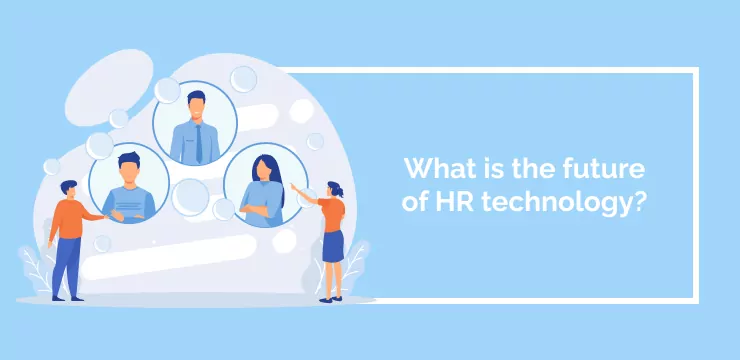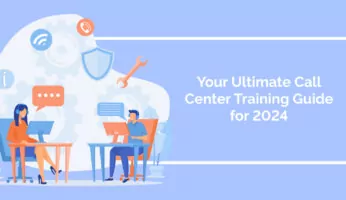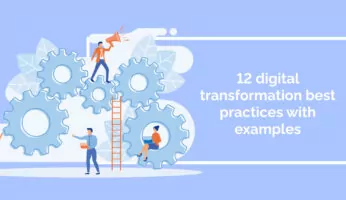
Although some staff may see HR as a means of punitive measures against undesirable behaviors, responding to HR tech trends enables HR professionals to work alongside employees to support their needs, promote diversity and become game changers for success.
However, Gartner reports that less than half (43%) of HR leaders feel that their employees are satisfied with the HR technology used by their organization.
As the beating heart of the employee lifecycle, from recruitment and onboarding to learning and offboarding, HR must be aware of the technologies available to help their organization excel.
For these reasons, we will guide you on the path to HR technology success via the following topics:
- Why are the different types of HR technology?
- What does HR use technology for?
- What are the benefits of HR technology?
- What is the future of HR technology?
Why are the different types of HR technology?
Like any area of professional life, it’s helpful to know the types of technology in a category to optimize your use and help you choose the best HR tech solutions for your organization.
WEBMASTER: Please embed below link, thanks!
This can get confusing with HR technology as all the acronyms for different types sound very similar. Let’s start with the differences between a few of these acronyms to make things more transparent.
HCM vs. HRIS and HRMS
HCM, HRIS, and HRMS are so similar that anyone, whether HR professionals or otherwise, is likely to get them mixed up. Let’s first look at HCM.
HCM
HCM is a method of converting the usual administrative tasks of HR into a digital form.
Examples of where an organization uses an HCM are:
- Recruitment
- Managing employee data
- Training
- Payroll
- Compensation
- performance management
- Increasing engagement, productivity, and business value
Using a DAP as an HCM adoption solution for high adoption rates and reduced waste is always helpful.
HRIS
The acronym HRIS stands for Human Resources Information System. This system gathers and retains information regarding an organization’s workforce.
An HRIS generally includes all the necessary features for complete HRM, such as:
- Recruitment
- Performance management
- Learning & development
HRMS
A suite of software applications called HRMS is used to manage human resources and processes throughout an employee’s lifecycle.
This system helps companies understand their workforce, comply with tax and labor regulations, and benefit employee experience management.
What are the benefits of HR technology?

Being aware of the potential benefits of human resources technology trends allows you to ensure you are constantly optimizing the use of HR tech. One of the first benefits of HR technology involves streamlined recruiting.
Streamlined recruiting
Are you struggling to find suitable candidates when it’s time to hire? HR technology can assist you and your managers make quicker and better hiring decisions.
The software might have an applicant tracking system that helps with hiring. You can create a database of qualified resumes to search and use when a position becomes available. The software can also help your managers organize interviews, keep track of feedback, and rank candidates.
Your company can effectively monitor the outcomes by incorporating personality or skills assessments. This will assist in streamlining the hiring process and ensure that suitable individuals are hired for the appropriate roles.
Real-time workforce analytics
If your business is not growing as expected despite repeatedly hiring new personnel, you can seek assistance from your HR specialist to analyze the available data. They can help you identify potential issues, such as frequent turnovers in a particular department and associated expenses.
Storing your HR information in a single database allows you to monitor both expenses and traits of prosperous, lasting workers. When necessary, this easy access to workforce analytics will simplify your planning.
HR compliance support
An HR platform can assist you in assessing whether your company will qualify as a different employer category due to an upcoming growth spurt.
For instance, hiring many employees may trigger FMLA or COBRA government-mandated regulations. With the help of HR software, you can fulfill the appropriate compliance obligations once you surpass the relevant employee threshold.
Reduced data-entry and duplication errors
Is your company still using paper-based or multiple separate systems for managing payroll, benefits, vacation, HR-related government reporting, and performance reviews? If this is the case, a staff member may manually enter data at some stage.
Investing in solid HR technology can automate repetitive tasks and integrate information across all systems, resulting in more efficient and accurate HR processes. This is important because manual data entry is time-consuming and prone to errors.
More resources to focus on HR strategy
Manual processes involving paper and transferring information between different systems are time-consuming, and this can result in significant costs. HR teams spend hours entering data and fixing errors caused by these processes.
How much are you spending on this? Could your team’s time and skills be better utilized on more strategic initiatives?
By implementing appropriate HR technology, your HR team can free themselves from performing routine tasks like data entry and administration.
Doing so enables them to utilize their time more effectively on generating revenue-centric activities like planning to expand the workforce and assisting managers in identifying and retaining top talent.
How does the HR department use technology?

Every HR department is different, but some standard functions run through them. Knowing HR technology’s capabilities will ensure you find the best-fit tech for your needs.
Payroll
Although some HR technology vendors focus solely on payroll, most HCM systems include payment and monitoring of employee wages and salaries, tax withholding, and other deductions.
HR technology payroll providers face a significant obstacle in managing wages, salaries, and taxes in various locations across the United States, including states and counties, as well as in different countries with unique government regulations.
Travel and expense management
HR departments use travel and expense software to offer travel services to employees, keep track of incurred expenses, make payments to providers, and reimburse employees through a link to the payroll service.
Expense report software is used by organizations to get automated analytics and reporting about their spending. Doing so helps managers have a clear view of the organization’s expenses.
Talent management
Talent management is a process that involves various tasks, such as recruiting, developing, evaluating, and compensating employees.
This process can be managed using separate applications or through a comprehensive talent management software suite that includes modules for recruitment and onboarding, learning and development, performance management, compensation management, and succession planning.
Several commonly used talent management and acquisition tools, such as the ATS (applicant tracking system), are available.
Talent management and acquisition tools
WEBMASTER: Please embed this link, thanks!
Talent Acquisition Tools to Build a Better Team Faster
The ATS is one of the leading talent management and acquisition tools, but there are several that HR departments use, as listed below.
- The Applicant Tracking System performs multiple tasks, such as advertising job vacancies on corporate websites and job boards, screening resumes, and sending interview invitations. Its functions include the following:
- Automatic resume ranking, pre-screening questions and response tracking, and support for different languages.
- Alongside ATS, a candidate relationship management tool helps recruiters keep a database of potential candidates who are not actively applying for jobs but can be contacted later if a suitable position opens up.
- Employee referral software enables HR to gather suggestions from current employees regarding potential and existing candidates.
Performance management
Employers are now automating HR tasks that were once done manually and are also adopting the practice of continuously monitoring employees’ job performance instead of relying on the traditional annual job review.
Whether integrated within HCM systems or standalone platforms, performance management systems may have interactive features that allow employees to provide feedback. This is known as continuous performance management.
By using employee performance management and skills data, workforce analytics aims to improve the allocation and development of human resources. It also helps to identify if new departments or positions are required.
Employee engagement
HR technology for employee engagement is becoming more popular in performance management. These platforms and apps use various methods to maintain employees’ interest and motivation toward their work.
Some apps have features like social media, such as commenting and posting. Additionally, there are communication platforms that employers can use to share information and allow employees to respond. Some apps use gamification to make the experience more fun and motivate employees.
Benefits administration
Benefits administration technology has been digitized more recently compared to core HCM tasks. This involves putting benefits information online, enabling employees to interact with their benefits choices conveniently.
In recent years, the meaning of benefits has expanded beyond health and disability insurance, vacation, and sick days, as digital transformation has accelerated.
HR technology vendors sell specialized software systems to encourage workers to participate in health-oriented wellness programs, some use wearable tracking devices to measure activity.
The terms wellness and well-being are being differentiated, and corporate well-being now encompasses engagement, health-oriented wellness, financial well-being for employees, and overall corporate morale.
Training
HR technology vendors are creating interactive online platforms to which corporate training and education programs are shifting.
Employers utilize learning management (LMS) software to create personalized training programs and monitor employee progress through real-time or asynchronous video or text-based communication.
The LMS may offer interactive features such as video conferencing, threaded discussions, and discussion forums and assess student performance. This applies to all users regardless of the format of communication.
What is the future of HR technology?

Every HR strategy should include future hr technology trends to utilize the best technologies available to meet organizational and staff needs. One of the biggest trends in HR today is generative AI, which can be of particular use to HR in recruitment.
Generative AI for recruitment
Generative AI, such as ChatGPT, is becoming a more significant part of HR operational processes as it reduces the time to recruit and retain new talent.
Generative AI can write a job advertisement in minutes and generate keywords for job descriptions to attract the most skilled and best-fitting candidates.
AI to increase HCM diversity
By using AI for sentiment analysis in company communications, we can recognize and correct language or behavior that excludes certain groups of people. This will lead to more inclusive communication that considers the requirements and worries of a varied workforce.
In addition to promoting workplace accessibility, AI can be used for speech recognition, text-to-speech, real-time transcription, and name pronunciation. To avoid awkwardness and quickly establish rapport, tools like Namecoach can help eliminate difficulties with name pronunciation.
AR for learning opportunities
Augmented Reality (AR) can be beneficial during presentations to engage learners and aid in retaining knowledge.
AR technology allows learners to interact actively with the content by moving around the room, enhancing the educational experience.
By integrating AR into presentations, learners can fully immerse themselves in the material and better understand complex concepts.
Tailor HR technologies to the needs of your staff
Leveraging HR technologies can make managing human resources managers’ most challenging tasks easier.
Whether optimizing employee experience, managing benefits and payroll information or providing training programs for existing and new staff members, HR technology is a practical solution for every process step.
With this strategy in mind, human resources managers can make their life easier while advancing their organization into an ever-competitive future of digital transformation. So keep this in mind: when leveraging HR technologies, tailor them to the needs of your staff to retain your talent and ensure organizational success.
WalkMe Team
WalkMe spearheaded the Digital Adoption Platform (DAP) for associations to use the maximum capacity of their advanced resources. Utilizing man-made consciousness, AI, and context-oriented direction, WalkMe adds a powerful UI layer to raise the computerized proficiency, everything being equal.



